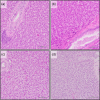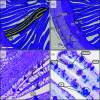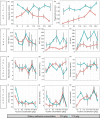Adequate levels of dietary sulphur amino acids impart improved liver and gut health in juvenile yellowtail kingfish (Seriola lalandi)
- PMID: 35924344
- PMCID: PMC10024990
- DOI: 10.1017/S0007114522002458
Adequate levels of dietary sulphur amino acids impart improved liver and gut health in juvenile yellowtail kingfish (Seriola lalandi)
Abstract
The sulphur amino acids methionine (Met) and cysteine (Cys) and their derivative taurine (Tau) are metabolically active molecules with interlinked roles in nutritional requirements. Deficiencies in these nutrients are linked to poor growth and health; however, the impacts of these deficiencies on organ structure and function are largely unknown. This study examined the effects of dietary Met, Cys and Tau fed at different levels on yellowtail kingfish (YTK) liver histology and surface colour, plasma biochemistry and posterior intestine histology. Samples were collected from two dose-response feeding trials that quantified (1) the Tau requirement and sparing effect of Met by feeding YTK diets containing one of seven levels of Tau at one of two levels of Met and (2) the Met requirement and sparing effect of Cys by feeding YTK diets containing one of five levels of Met at one of two levels of Cys. YTK fed inadequate levels of dietary Met, Cys and Tau exhibited thicker bile ducts, less red livers, more intestinal acidic goblet cell mucus and supranuclear vacuoles and less posterior intestinal absorptive surface area. Further, thicker bile ducts correlated with less red livers (a*, R), whereas increased hepatic fat correlated with a liver yellowing (b*). Our results indicate a shift towards histological properties and functions indicative of improved intrahepatic biliary condition, posterior intestinal nutrient absorption and homoeostasis of YTK fed adequate amounts of Met, Cys and Tau. These findings may assist in formulating aquafeed for optimised gastrointestinal and liver functions and maintaining good health in YTK.
Keywords: Aquaculture; Goblet cells; Liver histology; Methionine; Posterior intestine histology; Taurine; Yellowtail kingfish.
Figures









Similar articles
-
Effects of dietary choline on liver lipid composition, liver histology and plasma biochemistry of juvenile yellowtail kingfish (Seriola lalandi).Br J Nutr. 2021 Jun 28;125(12):1344-1358. doi: 10.1017/S0007114520003669. Epub 2020 Sep 18. Br J Nutr. 2021. PMID: 32943119
-
Alternative dietary protein and water temperature influence the skin and gut microbial communities of yellowtail kingfish (Seriola lalandi).PeerJ. 2020 Mar 19;8:e8705. doi: 10.7717/peerj.8705. eCollection 2020. PeerJ. 2020. PMID: 32219022 Free PMC article.
-
Intestinal Transcriptome Analysis Highlights Key Differentially Expressed Genes Involved in Nutrient Metabolism and Digestion in Yellowtail Kingfish (Seriola lalandi) Fed Terrestrial Animal and Plant Proteins.Genes (Basel). 2020 Jun 5;11(6):621. doi: 10.3390/genes11060621. Genes (Basel). 2020. PMID: 32517020 Free PMC article.
-
Molecular characterization and expression profiles of insulin-like growth factors in yellowtail kingfish (Seriola lalandi) during embryonic development.Fish Physiol Biochem. 2019 Feb;45(1):375-390. doi: 10.1007/s10695-018-0570-5. Epub 2018 Sep 17. Fish Physiol Biochem. 2019. PMID: 30225751
-
Amino Acids in the Nutrition, Metabolism, and Health of Domestic Cats.Adv Exp Med Biol. 2021;1285:217-231. doi: 10.1007/978-3-030-54462-1_11. Adv Exp Med Biol. 2021. PMID: 33770409 Review.
Cited by
-
Exploring the physiological plasticity of giant grouper (Epinephelus lanceolatus) to dietary sulfur amino acids and taurine to measure dietary requirements and essentiality.Fish Physiol Biochem. 2023 Oct;49(5):829-851. doi: 10.1007/s10695-023-01222-4. Epub 2023 Jul 28. Fish Physiol Biochem. 2023. PMID: 37507548 Free PMC article.
-
Effects of cysteine addition to low-fishmeal diets on the growth, anti-oxidative stress, intestine immunity, and Streptococcus agalactiae resistance in juvenile golden pompano (Trachinotus ovatus).Front Immunol. 2022 Nov 17;13:1066936. doi: 10.3389/fimmu.2022.1066936. eCollection 2022. Front Immunol. 2022. PMID: 36466908 Free PMC article.
-
Exploring single cell microbial protein as a sustainable fishmeal alternative in yellowtail kingfish (Seriola lalandi) diets: impacts on health and gut microbiome.J Anim Sci Biotechnol. 2025 Feb 2;16(1):16. doi: 10.1186/s40104-024-01146-w. J Anim Sci Biotechnol. 2025. PMID: 39893452 Free PMC article.
-
Sustainable Fishmeal Alternatives: Impact of Partially Defatted Black Soldier Fly (Hermetia illucens) Meal on Growth and Health of Yellowtail Kingfish (Seriola lalandi).Aquac Nutr. 2025 Jun 19;2025:1804215. doi: 10.1155/anu/1804215. eCollection 2025. Aquac Nutr. 2025. PMID: 40575011 Free PMC article.
References
-
- Baldwin CC (2003) FAO species identification guide for fishery purposes. The living marine resources of the western central Pacific. Copeia 2003, 212–214.
-
- Candebat CL, Booth M & Pirozzi I (2021) The sulfur amino acid requirements of juvenile yellowtail kingfish (Seriola lalandi). Aquaculture 534, 736234.
-
- Jirsa D, Davis A, Stuart K, et al. (2011) Development of a practical soy-based diet for California yellowtail, Seriola lalandi . Aquacult Nutr 17, e869–e874.
-
- Stephens F, Partridge G, Hill J, et al. (2021) Investigating ill thrift in yellowtail kingfish Seriola lalandi. Aquacult Pathophysiol 1, 1–12.
-
- Li X, Zheng S, Cheng K, et al. (2021) Use of alternative protein sources for fishmeal replacement in the diet of largemouth bass (Micropterus salmoides). Part II: effects of supplementation with methionine or taurine on growth, feed utilization, and health. Amino Acids 53, 49–62. - PubMed
LinkOut - more resources
Full Text Sources
Miscellaneous

